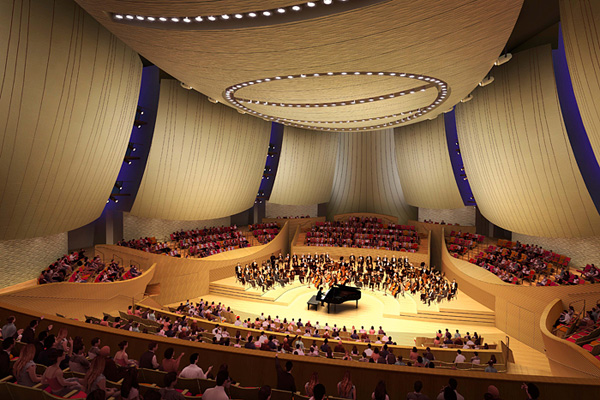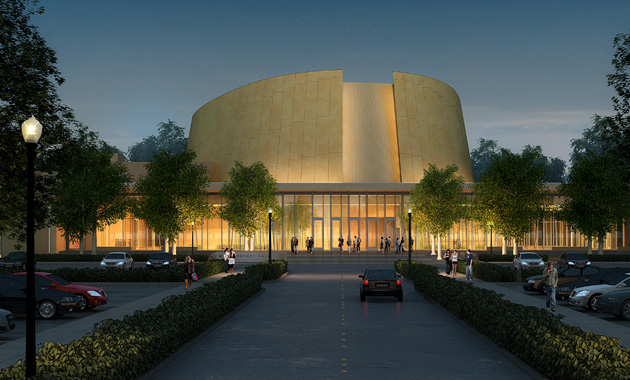Construction to begin on new concert hall
A cutting-edge concert hall launches an "arts district" at Stanford. Top architects and acousticians have designed the 844-seat Bing Concert Hall to accommodate everything from soloists to full orchestras, classical masterpieces to the latest computer-generated sounds.
On Tuesday, May 11, Stanford University will celebrate the groundbreaking for its state-of-the-art concert hall, which is slated for completion in summer 2012, with the first public performances in January 2013.
The 844-seat Bing Concert Hall has been designed for a wide range of music performances, from small chamber ensembles to full-sized orchestras, jazz, multi-media, newly commissioned works and world music, and has an architectural and acoustic plan from some of the foremost designers in the world.
The 112,000-square-foot hall will stand at the east end of Museum Way. It will be a short distance from the Cantor Arts Center, which is on the opposite side of Palm Drive, the university's palm-lined gateway to the campus.
The groundbreaking heralds an even more comprehensive Stanford vision: the launch of an arts district at the "front door" of the campus, just off Palm Drive, which is the extension of University Avenue, the main artery through downtown Palo Alto. The location will provide easy access to local visitors and those coming from the nearby highways.
For Stanford, the $111.9 million hall underscores a commitment to the arts that began with the Arts Initiative, a university-wide effort to integrate the arts and creativity into every field of study.
"The concert hall really is an enduring embodiment of what the Arts Initiative has been about," said Kären Nagy, assistant vice president for the arts at Stanford, who calls the new hall "a vibrant way to expose all the students of Stanford to the arts."
"That we're managing to do this building in the midst of these economic times is nothing short of extraordinary. It says very loudly that the arts are important at Stanford and we want to do them well," Nagy said.
The Bing Concert Hall, named in honor of major supporters Helen and Peter Bing, (a 1955 graduate of Stanford), will dramatically enhance the quality of performance space at Stanford.

The vineyard-style configuration of the hall will allow sound to radiate naturally.
It will be used for world-class visiting performers as well as Stanford's own community of faculty and student musicians – including the Stanford Symphony Orchestra and Symphonic Chorus; the Grammy-nominated St. Lawrence String Quartet, Stanford's ensemble-in-residence; and the composers and researchers at the Center for Computer Research in Music and Acoustics (CCRMA), widely known for its iPhone and laptop orchestras.
It also will be the primary venue for Stanford Lively Arts, whose 100 events a year bring in an audience of 30,000 annually. Stanford Lively Arts will manage the hall.
The hall has been designed by the internationally recognized Ennead Architects (whose clients include Carnegie Hall) and Fisher Dachs Associates (theater planning consultants to Lincoln Center and others). Nagata Acoustics' Yasuhisa Toyota, one of the world's foremost acousticians, has provided the acoustic design for the hall. Toyota's previous projects have included the Walt Disney Concert Hall in Los Angeles and Russia's Mariinsky Concert Hall in St. Petersburg. Cheryl Barton, whose firm is a pioneer in sustainable landscape design, is the landscape architect.
The hall will feature a vineyard-style configuration – a concert equivalent of "theater in the round" – with terraced sections wrapping around the stage. The shape of the concert hall will allow sound to radiate naturally, offering a superb natural acoustic. Its exceptional acoustics also will support amplified, electronic or computer-generated sound. Video screens on both sides of the room will be used for multimedia events.
The Bing Concert Hall will be intensely intimate: Not only will concertgoers be physically closer to the performers, they also will be almost on the same level with them, given the low elevation of the stage. Concertgoers will be facing each other, rather than a proscenium stage.
The hall has been designed from the inside out, with acoustics the top priority: "From the very beginning, it was incredibly clear that we were to make the acoustics the absolute best we could make them. That was the absolute number one goal," said Richard Olcott, design partner at Ennead.
According to Toyota, the building created a particular acoustical challenge, because of the range of performances and ensemble sizes to be accommodated – from small chamber concerts to symphony performances with full choruses of 150 singers.
Given that the concert hall is relatively small (San Francisco's Davies Symphony Hall is, by comparison, over three times larger), Toyota said the designers had to consider a sound that might be "too big for the space."
A crucial accommodation is the 47-foot-high ceiling – almost as high as the ceiling in a big concert hall – which will make the structure taller than most buildings on campus (the overall building height outside is 65 feet). According to Olcott, the ceiling design is "the ideal height to create a longer reverberation, a richer, fuller sound."
The acoustics determined the shape of the hall's exterior, which echoes the vineyard configuration with a distinctive, fez-shaped design. "It's very much about expressing the shape of that room – we wanted to express its roundness. We didn't want to put it in a box," said Olcott. "There was definite interest on our part for a pure and simple expression, and not tarting it up."
The building will be a distinctive one on an already distinguished campus: "The style of the original Main Quad was a unique language of Spanish and Romanesque," said Olcott. "It's a very beautiful and unique place and you could be nowhere else. It has a sense of identity – a powerful, architectural identity. It's so important to the essence of the place."
However, he said, when it came to designing the new concert hall, "No one was ever interested in Spanish tile roofs.
"The idea is a contemporary expression of the traditional, local material. And yes, it should somehow say, 'Oh, that's the Bing Concert Hall – not a classroom.' "
He accommodated the Stanford style instead with colonnades, arcades, porches, trellises and glass walls that open the view to the surrounding landscape.
Stanford, he said, "is a great place to build. The climate offers so many more possibilities."
A glass-enclosed foyer will provide space for lectures, receptions and other programming. The facility also will include a substantial rehearsal studio for campus and visiting performers, a state-of-the-art recording studio that will be linked to the main hall and the rehearsal studio, artists' suites, and a performers' lounge and garden.
According to Stanford architect David Lenox, "Bing Concert Hall will be the first note for a long-range vision for the new arts district as you enter campus."
The Deedee and Burt McMurtry Building will strike a second. Planning will begin this year for the new building that will house the Department of Art and Art History, next to the Cantor Arts Center.
Currently, music, drama, dance, visual arts, film and creative writing are scattered across Stanford's large campus. The proposed arts district will consolidate them where the Graduate School of Business is currently located, next to Memorial Auditorium. (The Business School will move to new quarters, now under construction, at Serra Street and Campus Drive.)
These programs, along with the new concert hall, will join the Thomas Welton Art Gallery, the Cantor Arts Center and Memorial Auditorium to form the arts district.
"What will be nice about coming onto campus in the future is that you'll know that the culture and arts are a complement to the medical, law, engineering, education, medicine, business components at Stanford," said Lenox.
For architect Olcott, "Certainly building at Stanford is a challenge and an honor. Stanford has had a very, very high-quality attitude, trying to get the best building they can get.
"We've been at this for over two-and-a-half years. Obviously, we're thrilled it's going forward," he said. "We hope it's a wonderful place to hear music."
Media Contact
Cynthia Haven, Stanford News Service: (650) 724-6184, cynthia.haven@stanford.edu
Robert Cable, Stanford Lively Arts: (650) 736-0091, rcable@stanford.edu


Share This Story